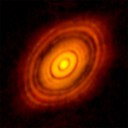AAAS 2016: Planet Formation With Radio Eyes
AAAS 2016 Science Symposium: Planet Formation With Radio Eyes
 | Washington, DC 8:00 AM to 9:30 AM Saturday, 13 February 2016 |
|---|
Radio-wavelength emission is little affected by intervening dust and gas and observations with radio telescopes are key to improving our understanding of star and planet formation and the dust-shrouded environments where these processes occur. Astronomers around the world are exploring new discovery space and scientific frontiers using much more capable arrays and large, single dish radio telescopes, including the Atacama Large Millimeter/submillimeter Array, Very Large Array, Plateau de Bure Interferometer, 100-m Green Bank Telescope, and 45-m Nobeyama Radio Observatory. The much improved sensitivity, resolution, and imaging quality of these telescopes are enabling a revolution in our understanding of the physics and chemistry of star and planet formation. Recent radio images have revealed telltale tracks in heavily obscured nearby disks, for example, that are presumably signatures of planet formation. Scientists are now probing how, where, and when planets form and are analyzing the links between planetary system architecture and the properties of the parent circumstellar disk. Though the relationship of planetary to stellar masses remains obscure, it is clear that most stars host planets. This symposium will describe the state-of-the-art radio-wavelength observing campaigns being used by astronomers to probe planet formation and will sample the new scientific results that radio telescopes are yielding in this exciting field.
Organizer: Mark Adams
Speakers
1. Kevin Flaherty (Wesleyan University)
Debris as a Window into New Planetary Systems
 |
After planetary systems form, small bodies analogous to Kuiper Belt Objects collide and produce dusty debris that can be seen around distant stars with radio interferometers. The structure of such debris disks is intimately connected with the dynamics of young planetary systems. I will describe how recent spectacular Atacama Large Millimeter/submillimeter Array observations of debris disks are revealing the properties of emerging planetary systems and the processes by which they form and evolve. |
|---|
2. Andrea Isella (Rice University)
Mapping Newborn Planetary Systems
 |
Mapping planetary systems in the act of forming is key to understanding how planets form and why exoplanetary systems exhibit such an impressive variety of properties. I will present an overview of recent results based on high-angular resolution observations acquired with the Atacama Large Millimeter/submillimeter Array and the Jansky Very Large Array that are enabling astronomers to map newborn planetary systems on scales smaller than our Solar System. |
|---|
3. David J. Wilner (Harvard-Smithsonian Center for Astrophysics)
Observations of Circum-Planetary Disks with ALMA
 |
The hundreds of disks around nearby young stars serve as analogs to the nebula that spawned our Solar System. A new generation of millimeter telescopes provide direct access to the cool material in these disks, enabling resolved observations of solids, as well as the thermal, chemical, and dynamical structure of gas. I will discuss recent advances obtained with the revolutionary capabilities of the Atacama Large Millimeter/submillimeter Array, in particular initial efforts to detect circum-planetary disks around planetary mass companions on wide orbits around young stars.
|
|---|




Connect with NRAO